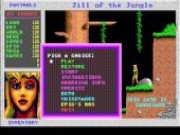
Jill of the Jungle is a platform sidescroller which was released during the same time as the Commander Keen and Duke Nukem series of games. Players play as an Amazon woman who can use various types of weapons and enhancements as you progress through levels slaying monsters and finding keys. The first game in the series contains 16 levels, each of which can be entered from an overworld resembling another level. The second game uses sequential levels without an overworld. The third game's overworld is a top-down perspective, similar to The Legend of Zelda, changing back to the traditional platformer style when entering a level. Various puzzles include keys, transforming into different creatures, and proper jump height among others. The other games in the series use the same graphics, except that Jill's costume is recolored in each game (green in the first game, red in the second, and blue in the last). Each episode has several unique music tracks and sound effects but some songs and sounds are used either in two or three different episodes. For instance, the apple pickup sound remains the same through the game. Jill of the Jungle also offered a "noisemaker", acting as a sound test, in which each sound effect in the game was mapped to each key of the keyboard. This was carried on by Epic's later game Kiloblaster, which is advertised repeatedly during the Jill of the Jungle trilogy. Between levels in the shareware version, the player encountered humorous messages that took a swipe at various popular game characters, such as Mario, Commander Keen and Duke Nukem. The messages usually described that they were retiring, supposedly due to being unable to compete with Jill. The game does not contain any boss fights. Jill of the Jungle provided market recognition and allowed Epic Megagames to produce future titles, such as Jazz Jackrabbit, One Must Fall: 2097, and the very successful Unreal series of games. The game Xargon, a later creation of Epic, was very similar in terms of gameplay.
Each game uses different controls, most DOS games use the keyboard arrows. Some will use the mouse , "Alt" ,"Enter" and "Space bar".